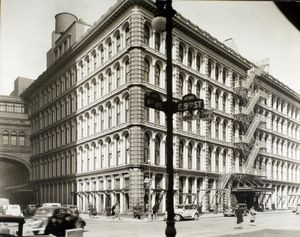East 9th Street in New York City, a seemingly ordinary thoroughfare in the bustling landscape of Manhattan, holds a captivating history beneath its modern facade. A look back in time reveals a street dramatically different, particularly in the section between Broadway and 4th Avenue. Once upon a time, this very stretch was defined by an architectural marvel, a “Bridge of Progress” that spoke volumes about the city’s burgeoning retail scene.
This “then and now” juxtaposition vividly illustrates the transformation of East 9th Street. Where pedestrians now freely traverse the street, early 20th-century shoppers once strolled across an elaborate elevated walkway. This sky bridge was the brainchild of Wanamaker’s Department Store, connecting its main building to its annex and becoming a prominent feature of the neighborhood. The photograph from 1924 perfectly captures this era, showcasing a bygone architectural element that has since vanished from the streetscape.
 East 9th Street in New York City: A Then and Now Comparison of Wanamaker's Bridge of Progress
East 9th Street in New York City: A Then and Now Comparison of Wanamaker's Bridge of Progress
The story of this bridge begins with Alexander Turney Stewart, a pioneering figure in the department store industry. In 1862, Stewart erected the grand building north of East 9th Street, between 9th and 10th Streets. Later, in 1896, John Wanamaker of Philadelphia acquired this building, establishing his first New York outpost of the renowned Wanamaker’s Department Store. To expand his retail empire, Wanamaker constructed an annex building on the opposite side of East 9th Street between 1903 and 1907. This annex, which still stands today and houses a Kmart and office spaces, was ingeniously linked to the main store via the now-famous sky bridge. This annex building is a significant part of the NoHo Historic District, a testament to the area’s architectural and historical importance.
 Wanamaker's Department Store on East 9th Street, New York, early 20th Century
Wanamaker's Department Store on East 9th Street, New York, early 20th Century
Wanamaker’s was not alone in defining the retail landscape around 14th Street and East 9th Street. This area, during the late 19th and early 20th centuries, was a department store mecca. Alongside Wanamaker’s, iconic names like Macy’s (whose 14th Street building is a landmark consideration), Lord & Taylor, B. Altman, and S. Klein thrived, forming the southern anchor of the “Ladies’ Mile.” This stretch was a shopper’s paradise, a concentrated zone of grand department stores that drew shoppers from across the city and beyond.
Just as New York City’s theater district migrated uptown, so too did its retail heart. From downtown near City Hall, to Union Square, and then further north to Times Square and 42nd Street, the city’s entertainment and commercial centers shifted with changing demographics and urban development. Similarly, the major retail players gradually moved away from the Union Square/Ladies’ Mile area. By the mid-20th century, the retail giants had largely relocated to the 34th Street/Herald Square neighborhood, marking a new chapter in New York City’s retail evolution.
Wanamaker’s, too, eventually moved with the times. In 1955, the department store sold its northern building on East 9th Street. Before planned demolition could occur, a fire in 1956 ravaged the structure. In 1960, the Stewart House, a large white-brick residential building, was erected in its place, a stark contrast to the ornate department store that once stood there, and a final erasure of the “Bridge of Progress” from the East 9th Street vista. The story of East 9th Street reflects the dynamic nature of New York City, a place of constant change and reinvention, where the echoes of grand department stores and sky bridges linger beneath the surface of the modern cityscape.


